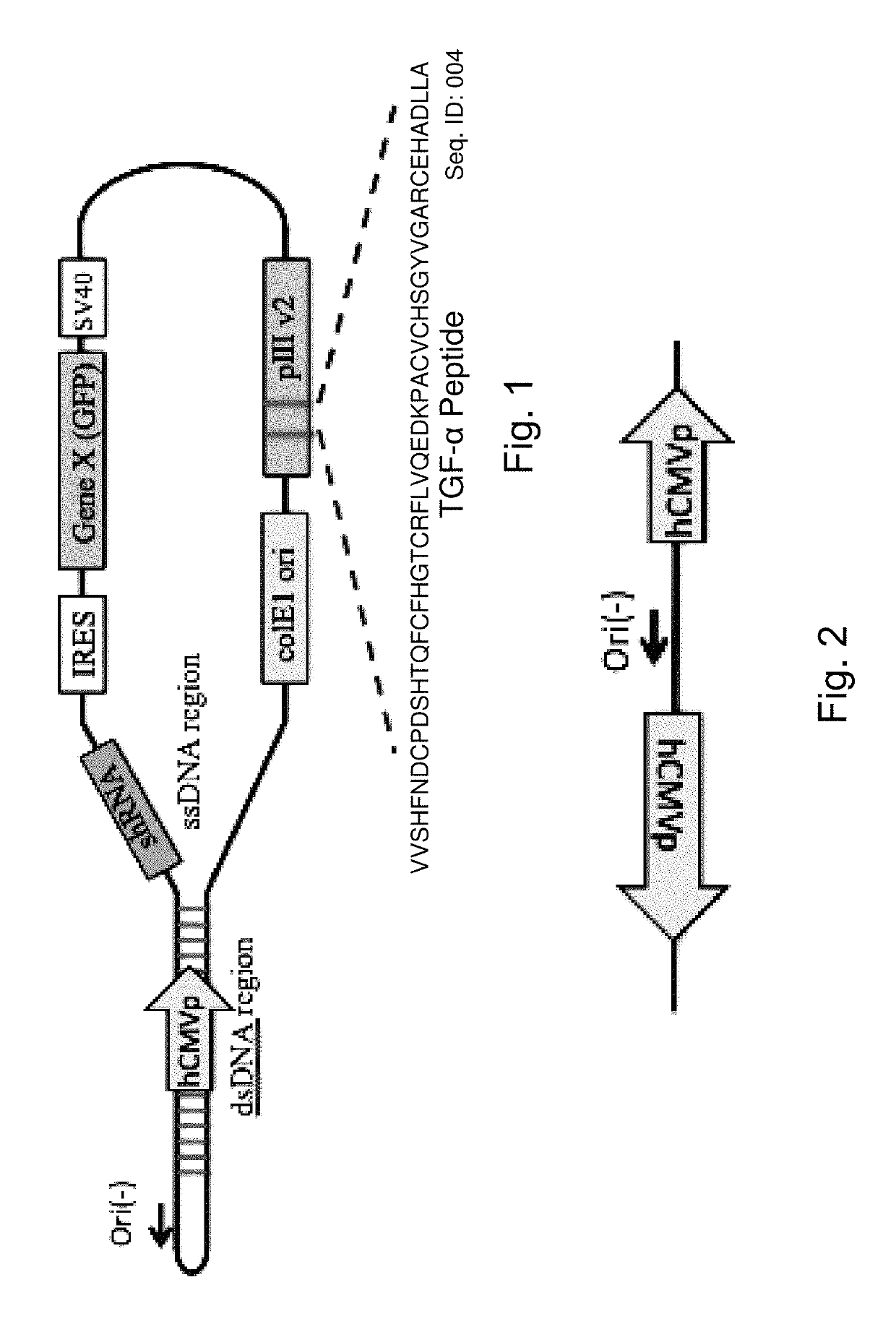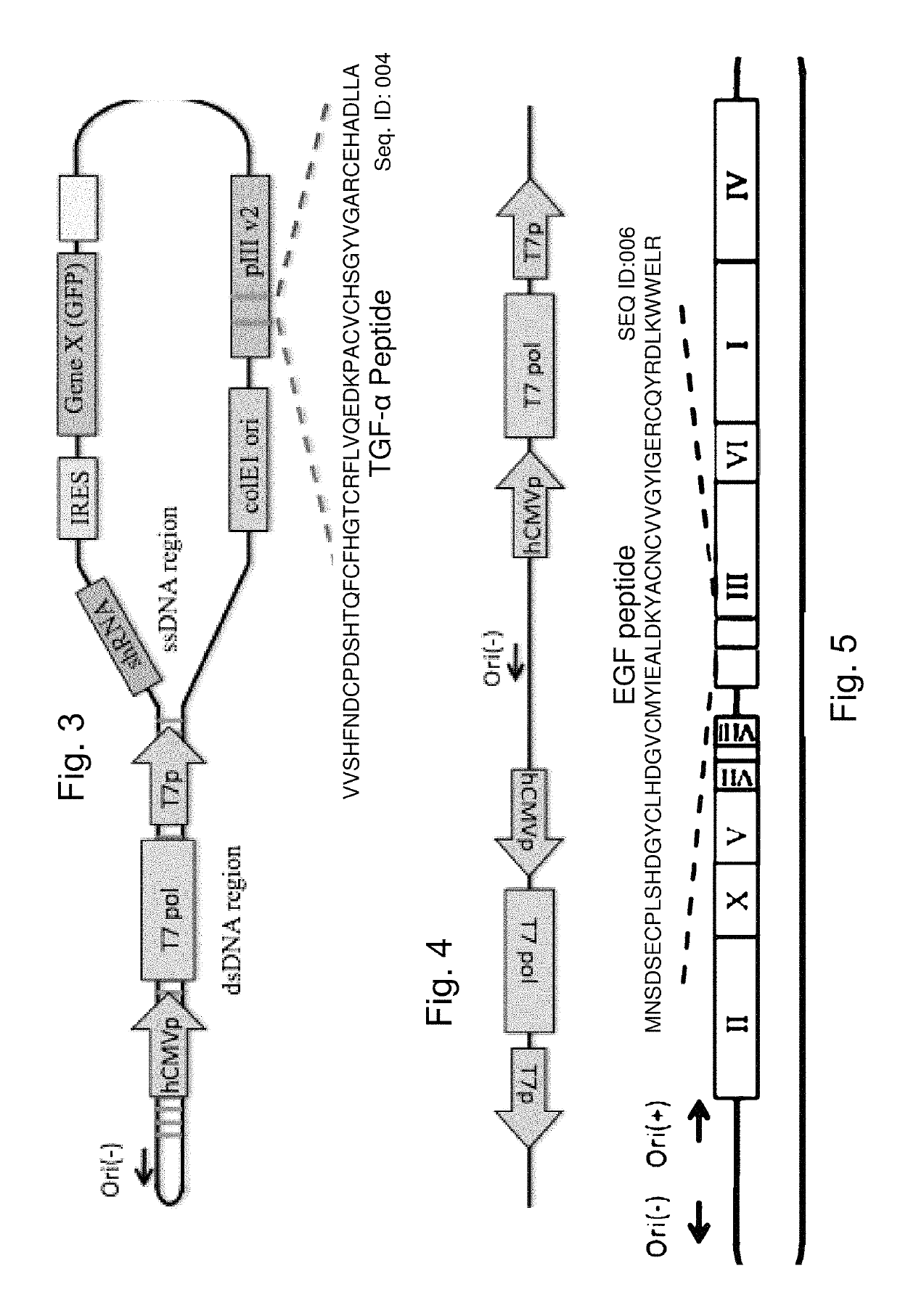Bacteria carrying bacteriophage and protease inhibitors for the treatment of disorders and methods of treatment
a protease inhibitor and bacteria technology, applied in the field of therapeutic delivery systems, can solve the problems of reducing the treatment effect of parasitic worms, reducing the number of patients, so as to improve the design of parasitic worms, enhance the production efficiency of rna, and increase the effect of transcription
- Summary
- Abstract
- Description
- Claims
- Application Information
AI Technical Summary
Benefits of technology
Problems solved by technology
Method used
Image
Examples
example 1
ion of Gram Positive Probiotic Bacteria Expressing Phage which can be Molecularly Targeted
[0116]By way of example, the probiotic, commensal or attenuated pathogenic gram positive bacterium may be a Lactococcus or Lactobacillus. The Gram positive bacteria will express targeting peptides and / or antibodies as a fusion protein with the homologue of the M13 filamentous phage pIII protein, the p6 protein from the filamentous phage B5 (Chopin et al. 2002 Filamentous Phage Active on the Gram-Positive Bacterium Propionibacterium freudenreichii J Bacteriol. 184(7): 2030-2033)). The targeting peptides and or antibodies are inserted into the B5 p6 protein immediately after the signal sequence which consists of the 39 amino acids[0117]MFGVKRSWLRRWVRAVAAFAVGALVVVGVGVASFAPRASAAND SEQ ID:007
the adjacent 40th amino acid A (alanine), followed by synthetically inserted EcoR1, SwaI and BamH1 (which are otherwise absent in the B5 genome, making then unique and useful for addition of targeting sequences)...
example 2
ion of Gram Positive Probiotic Bacteria Expressing Phage where the Phage Express an mRNA which can Serve as an RNA Therapeutic
[0118]The modified B5 phage of Example 1 are further modified using methods known to those skilled in the art to express an mRNA when transfected to a eukaryotic host cell, such as the pCMV promoter which is functional within a eukaryotic host cell together with an adjacent polylinker. The polylinker which in this case carries engineered sites that are otherwise absent in the phage, EcoRV, NdeI, SacI, SspI facilitates cloning of therapeutic DNA and RNA molecules which will generate mRNA transcripts. Addition of an internal ribosomal entry site (IRES) is used to facilitate the targeting of more than one miRNA or deliver of more than one pri-miRNA, or the combination of inhibiting miRNA and delivery of pri-miRNA.
[0119]The resulting phage is useful for further modifications as described below for generating probiotic bacteria that express phage with targeting pe...
example 3
randed Anti-miRNA for the Treatment of Psoriasis
[0120]The phage used are those described by Bermudes (U.S. Pat. No. 8,241,623, Protease sensitivity expression system, expressly incorporated herein by reference), or as modified further as described in Examples 1 and 2. Anti-miR-203, an miRNA that is upregulated in psoriasis, is targeted using a single-stranded DNA phage generating an RNA transcript with complementary sequence to miR-203:[0121]GUGUUGGGGACUCGCGCGCUGGGUCCAGUGGUUCUUAACAGUUCAACAGUUCUG UAGCGCAAUUGUGAAAUGUUUAGGACCACUAGACCCGGCGGGCGCGGCGACAGCG SEQ ID:008
[0122](Sonkoly, et al., 2007, MicroRNAs: Novel Regulators Involved in the Pathogenesis of Psoriasis? PLoS ONE 2(7): e610. doi:10.1371 / journal.pone.0000610). In order to facilitate the phage targeting to karatinocytes, the targeting ligands for fibronectin (Jensen et al. Mol Cell Proteomics. 2003 February; 2(2):61-9 or Zong et al., Keratinocyte growth factor phage model peptides can promote epidermal cell proliferation without ...
PUM
| Property | Measurement | Unit |
|---|---|---|
| time | aaaaa | aaaaa |
| length | aaaaa | aaaaa |
| chromatin structure | aaaaa | aaaaa |
Abstract
Description
Claims
Application Information
 Login to View More
Login to View More - R&D
- Intellectual Property
- Life Sciences
- Materials
- Tech Scout
- Unparalleled Data Quality
- Higher Quality Content
- 60% Fewer Hallucinations
Browse by: Latest US Patents, China's latest patents, Technical Efficacy Thesaurus, Application Domain, Technology Topic, Popular Technical Reports.
© 2025 PatSnap. All rights reserved.Legal|Privacy policy|Modern Slavery Act Transparency Statement|Sitemap|About US| Contact US: help@patsnap.com


